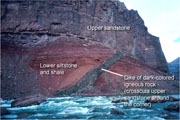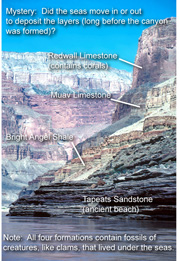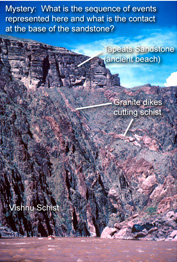
Precambrian rocks in the bottom of the canyon at Hance Rapids, eastern Grand Canyon. The lower red rock unit is siltstone and shale, and the upper rock is sandstone. There is also a dark-colored igneous rock. What are the relative ages of these three rocks?

Paleozoic rocks at Stephen's Isle, central Grand Canyon. The bottom ledge is Tapeats Sandstone, representing an ancient beach, overlain by slope-forming Bright Angel Shale and Muav Limestone, with cliff-forming Redwall Limestone (contains corals) at the top on the right. All four formations contain marine fossils. What changes in the environment could account for this sequence of rocks?

Inner Granite Gorge, upstream from Phantom Ranch, central Grand Canyon. The lower unit is dark Precambrian metamorphic rocks (Vishnu Schist) cut by pinkish granite dikes; the upper unit is Cambrian Tapeats Sandstone. What is the sequence of events represented here, and what is the contact at the base of the sandstone?